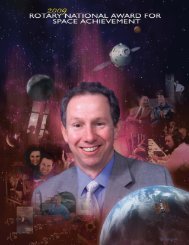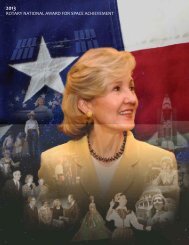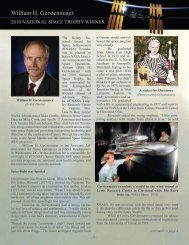Bill Gerstenmaier - RNASA
Bill Gerstenmaier - RNASA
Bill Gerstenmaier - RNASA
You also want an ePaper? Increase the reach of your titles
YUMPU automatically turns print PDFs into web optimized ePapers that Google loves.
Mike Griffin<br />
NATIONAL SPACE TROPHY PRESENTER<br />
The <strong>RNASA</strong> Foundation<br />
is pleased to<br />
have the 2009 National<br />
Space Trophy<br />
winner, former<br />
NASA Administrator<br />
Mike Griffin,<br />
return as a Trophy<br />
presenter. "It<br />
was my honor to<br />
work with <strong>Bill</strong> for<br />
four years," Griffin<br />
told <strong>RNASA</strong>.<br />
"Quite simply, <strong>Bill</strong><br />
<strong>Gerstenmaier</strong> is<br />
regarded as the ultimate<br />
authority on<br />
Space Shuttle and<br />
International Space<br />
Station. When he<br />
Mike Griffin (NASA, 2009)<br />
says something,<br />
people listen, and<br />
they know that<br />
what he says is true."<br />
Griffin was born in 1949 in Aberdeen, Maryland. He<br />
graduated from Aberdeen High School in 1967 and attended<br />
Johns Hopkins University (JHU) where he obtained his BA<br />
in physics in 1971. His first job was with Link Division of<br />
Singer Corporation. In 1974, he joined Computer Science<br />
Corporation to work in Mission Operations at NASA Goddard<br />
in Maryland.<br />
Griffin completed a master's in aerospace science<br />
from Catholic University in 1974, and his PhD in aerospace<br />
engineering from the University of Maryland in 1977. He<br />
later earned master’s degrees in electrical engineering from<br />
the University of Southern California, applied physics from<br />
Johns Hopkins, civil engineering from George Washington<br />
University, and business administration from Loyola College<br />
of Maryland.<br />
In 1977, Griffin joined the Jet Propulsion Laboratory<br />
in California to work on Mars rover and sample return<br />
programs. In late 1979, he returned to JHU where he worked<br />
on hypersonics, the Hubble Space Telescope, the Air Force<br />
Polar BEAR satellite, the Shuttle Astro-1 payload, and on<br />
missile defense for the Strategic Defense Initiative Organization<br />
(SDIO). He also taught aerospace engineering at the<br />
University of Maryland from 1980-86.<br />
He joined American Rocket Co., in California in<br />
1986 and worked on commercial low-cost launch vehicle<br />
development. In 1987, he went to work for the SDIO.<br />
Griffin taught aerospace engineering at George<br />
Washington University in DC and co-authored, with James<br />
French, the textbook, Space Vehicle Design (American Insti-<br />
- 10 -<br />
tute of Aeronautics and Astronautics, 1991, 2nd ed., 2004).<br />
Griffin was NASA Associate Administrator for Exploration<br />
from 1991-93. He was co-director of the Access to<br />
Space Study, team leader for the space station redesign, and<br />
led NASA efforts to analyze the Mars Observer failure. In<br />
1993, Griffin was named NASA’s chief engineer, responsible<br />
for review of all NASA programs, including the Hubble<br />
repair.<br />
Griffin served as general manager of Space Industries<br />
in Houston from 1994-95. He then joined Orbital Sciences<br />
in Virginia as Space Systems Group manager, responsible<br />
for all space systems development programs including<br />
the X-34 reusable launch vehicle and the ORBCOMM and<br />
ORBVIEW satellite constellations. He later became chief<br />
executive officer of Magellan Systems, Inc., a division of<br />
Orbital Sciences.<br />
In 2002, Griffin became president and COO of In-<br />
Q-Tel working on advanced technologies for CIA applications.<br />
He then returned to JHU as Space Department head.<br />
He initiated ISO9001 quality management certification efforts<br />
and oversaw the preparation, launch, and early operations<br />
of the MESSENGER spacecraft that launched to Mercury<br />
in 2004.<br />
He was selected as NASA Administrator by President<br />
Bush in 2005. Griffin developed the plan for completion<br />
of the International Space Station following the loss of<br />
Space Shuttle Columbia and directed the return to flight. He<br />
also initiated the first procurement of commercial cargo and<br />
crew service in the agency’s history. He left NASA in January<br />
2009, and became a professor at the University of Alabama<br />
in Huntsville.<br />
Griffin is a Registered Professional Engineer in<br />
Maryland and California, a member of the National Academy<br />
of Engineering and the International Academy of Astronautics,<br />
an honorary fellow of AIAA (2006), a fellow of the<br />
American Astronautical Society (2002), and a senior member<br />
of the Institute of Electrical and Electronic Engineers.<br />
In addition to the 2009 National Space Trophy, Griffin<br />
is the recipient of many honors, including the Defense<br />
Department’s highest award conferred on a non-government<br />
employee, Distinguished Public Service Medal (1986); the<br />
AIAA Space Systems Medal (1988), the Significant Technical<br />
Accomplishment Award (Delta 183 Mission Team) from<br />
the American Defense Preparedness Association (1989); the<br />
NASA Exceptional Achievement Medal (1994); the Goddard<br />
Astronautics Award (2007); selection by Time Magazine<br />
as one of the 100 Most Influential People of 2008, and<br />
the 2009 Goddard Trophy.<br />
Griffin is married to the former Rebecca (Becky)<br />
Lee Hann whom he met in Houston in the early 90s. Dr.<br />
Griffin also has three children from a previous marriage.<br />
Besides flying and golf, Griffin enjoys amateur radio, skiing,<br />
and scuba diving.





